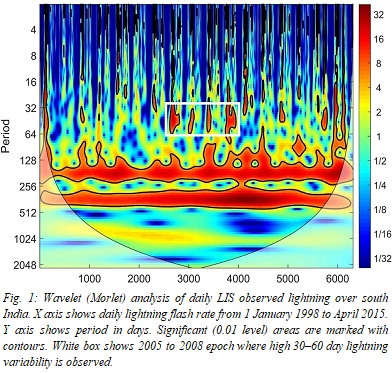 Lightning characteristics in India are examined with satellite-based Lightning Imaging Sensor (LIS) and ground-based Indian Lightning Detection Network (ILDN). LIS observations indicated that synoptic weather systems are major contributors of lightning in Indian hotspots. Western disturbances (mid-tropospheric systems with extratropical origin) were the greatest contributor of lightning in the Himalayas (93%), tropical cyclonic storms and low-pressure systems (oceanic in origin) were key lightning contributors in parts of eastern India (43%), and lower tropospheric troughs were major contributors in other hotspots. For the first time, this study reported the occurrence of significantly high lightning activity before active monsoon spells in the Central India region (65–87° E, 18–27° N). Consequently, satellite-based lightning observations could be used to predict active monsoon spells. Harmonic analysis was used to study diurnal lightning-flash density. The maximum observed standardized diurnal amplitude of lightning activity was 0.35, and maximum explained diurnal variation was 15%. Also, for the first time, we compared the ILDN data and LIS observations, and found good agreement regarding lightning variability. LIS data showed an increase in annual lightning activity in tropical South-western India (SWI), and the results also suggested that during El Niño and negative Indian Ocean Dipole periods, SWI experiences above-average lightning activity.
Lightning characteristics in India are examined with satellite-based Lightning Imaging Sensor (LIS) and ground-based Indian Lightning Detection Network (ILDN). LIS observations indicated that synoptic weather systems are major contributors of lightning in Indian hotspots. Western disturbances (mid-tropospheric systems with extratropical origin) were the greatest contributor of lightning in the Himalayas (93%), tropical cyclonic storms and low-pressure systems (oceanic in origin) were key lightning contributors in parts of eastern India (43%), and lower tropospheric troughs were major contributors in other hotspots. For the first time, this study reported the occurrence of significantly high lightning activity before active monsoon spells in the Central India region (65–87° E, 18–27° N). Consequently, satellite-based lightning observations could be used to predict active monsoon spells. Harmonic analysis was used to study diurnal lightning-flash density. The maximum observed standardized diurnal amplitude of lightning activity was 0.35, and maximum explained diurnal variation was 15%. Also, for the first time, we compared the ILDN data and LIS observations, and found good agreement regarding lightning variability. LIS data showed an increase in annual lightning activity in tropical South-western India (SWI), and the results also suggested that during El Niño and negative Indian Ocean Dipole periods, SWI experiences above-average lightning activity.
Bibliographic Info: Unnikrishnan, C. K., Sunil Pawar, Gopalakrishnan, V. [2021]. Satellite-observed lightning hotspots in India and lightning variability over tropical South India. Advances in Space Research, Vol. 68 (4), pp. 1690-1705. https://doi.org/10.1016/j.asr.2021.04.009




 सूचना का अधिकार
सूचना का अधिकार
